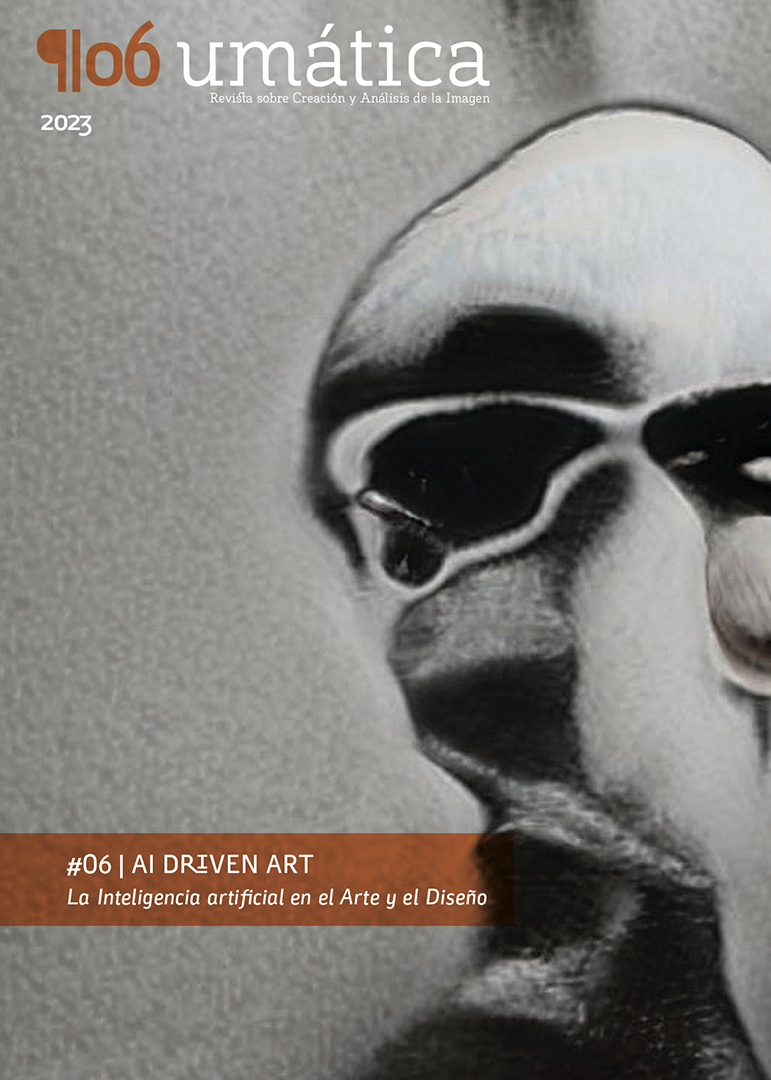Dismantle to Assemble: Reverse Engineering as an Artistic Methodology
La ingeniería inversa como metodología artística
DOI:
https://doi.org/10.24310/umatica.2023.v5i6.17818Keywords:
Technology, opacity, reverse engineering, art, methodologyAbstract
This visual essay titled Dismantle to assemble explains the reverse engineering, commonly associated with the field of computing, as an artistic methodology. In this sense, pictures, diagrams and sounds used to document how I dismantled electric devices act as breadcrumbs in the famous tale Hänsel and Gretel by the Brothers Grimm. This is, they allow us to reverse the path already taken and analyse the role of the different internal components of the electronic devices, as the traditional definition of reverse engineering determine. However, the possibility of recycling the internal components of electronic devices, as well as the graphic materials that document their disassembly and their connection with Nicolas Bourriaud’s concept Postproduction, allow bringing reverse engineering to a next level. Specifically, the destructive act against the electric device becomes a link between two apparently disassociated disciplines, art and technology, which helps us understanding the meaning and symbology of internal electronic components, as well as their closed use protocols with the objective of reversing the technological opacity that we find in contemporary electrical devices.
Downloads
Metrics
Publication Facts
Reviewer profiles N/A
Author statements
Indexed in
-
—
- Academic society
- N/A
- Publisher
- Universidad de Málaga (España)
References
Bourriaud, N. (2009). Postproducción. Adriana Hidalgo editora.
Carrubba, L. (2008). Estereotips – Interactive, free Technology and open education. Página web oficial del artista Luca Carrubba. https://estereotips.net/index.html%3Flang=es.html.
Chang, M. T. (2021). Artist’s Tools: Reverse-Engineering of Prototypes. https://academicworks.cuny.edu/cc_oers/296/
Chikofsky, E. y Cross, J. (1990). Reverse engineering and design recovery: a taxonomy. IEEE Software, 7(1), 13-17. https://doi.org/10.1109/52.43044.
Fontcuberta, J. (2016). La furia de las imágenes. Galaxia Gutenberg.
Galloway, A. (2010). Black box, Black bloc. A lecture given at the New School in New York City. http://cultureandcommunication.org/galloway/pdf/Galloway_Black_Box_Black_Bloc.pdf.
Grimm, J. y Grimm, W. (1985). Hänsel y Gretel. En. M. A. Seijo (Ed. y Trad.). Cuentos de niños y del hogar 1 (pp. 114-123). Anaya.
Kozak, C. (Ed.). (2012). Tecnopoéticas argentinas: archivo blando de arte y tecnología. Caja Negra.
Latour, B. (2021). La esperanza de Pandora. Estudios sobre la realidad de los estudios en la ciencia. Gedisa.
Levy, S. (2001). Hackers: heroes of the computer revolution. Penguin.
Manovich, L. (2017). El lenguaje de los nuevos medios de comunicación. La imagen en la era digital. Editorial Paidós.
Mora, V. L. (2012). La opacidad tecnológica: lo que no vemos en las màquinas, CCCB: Centro de Cultura Contemporània de Barcelona.
Rekoff, M. G. (1985). On reverse engineering. IEEE Transactions on systems, man, and cybernetics, 15(2), 244-252. https://doi.org/10.1109/TSMC.1985.6313354.
Roig, G. (2007). Hacktivismo. Hackers y Redes Sociales. Revista de Estudios de Juventud, 76(11), 201-223. https://www.injuve.es/sites/default/files/Revista-76-capitulo-11.pdf
Smith, S., Smith, G., y Shen, Y. T. (2012). Redesign for product innovation. Design Studies, 33(2), 160-184.
Stallman, R. (2004). Software libre para una sociedad libre. Traficante de sueños.
Tiselli, E. (2012). Why I have stopped creating E-Lit. Netartery. Synthesis of arts & ideas. https://netartery.vispo.com/?p=1211
Downloads
Published
How to Cite
Issue
Section
License
Copyright (c) 2023 Marc Anglès Cacha

This work is licensed under a Creative Commons Attribution-NonCommercial-ShareAlike 4.0 International License.
All contens publishes in Umática.Revista sobre Creación y Anáisis de la Imágen are protected under the Creative Commos Attribution-NonComercial-ShareAlike 4.0 International (CC-BY-NC-SA 4.0) license.
All about this license is available in the following link: <http://creativecommons.org/licenses/by-nc-sa/4.0>
Users can copy, use, redistribute, share and exhibit publicly as long as:
- The original source and authorship of the material are cited (Journal, Publisher and URL of the work).
- It is not used for comercial purposes.
- The existence of the license and its especifications are mentioned.
There are two sets of authors’ rights: moral and property rights. Moral rights are perpetual prerogatives, unrenounceable, not-transferable, unalienable, imprescriptible and inembargable. According to authors’ rights legislation, Umática.Revista sobre Creación y Anáisis de la Imágen recognizes and respects authors moral rights, as well as the ownership of property rights, which will be transferred to University of Malaga in open access. The property rights are referred to the benefits that are gained by the use or the dissemination of works. Fotocinema. Umática.Revista sobre Creación y Anáisis de la Imágen is published in an open access form and it is exclusively licenced by any means for doing or authorising distribution, dissemination, reproduction, , adaptation, translation or arrangement of works.
Authors are responsable for obtaining the necessary permission to use copyrighted images.
Copyright note: Authors who have publications with this journal agree and certify to the following terms:
- That he/she has contributed directly to the intellectual content of the work, for which he/she is responsible for all purposes.
- That he/she approves the contents of the manuscript submitted to the editorial process of UMÁTICA, REVISTA SOBRE CREACIÓN Y ANÁLISIS DE LA IMAGEN, and therefore agrees that his/her name appears as the author(s).
- That the content of the article has not been published and that it does not appear in any other work that is about to be published.
- That he/she agrees not to submit it for consideration of another publication while it is in the process of being reviewed by UMÁTICA, REVISTA SOBRE CREACIÓN Y ANÁLISIS DE LA IMAGEN, nor later in case it is accepted for publication.
- That he/she has not had, nor does any personal or financial affiliations that could prejudice the development or results of the present work.
- That all those persons who have made a substantial contribution to the development of the work, having given their permission for the mention, have been mentioned in the acknowledgments section.
- That he/she agrees to provide, when required by the journal, access to all the data and sources on which the work presented is based.
- That he/she will actively participate in the realization of all those stylistic or orthographic-typographic modifications necessary for the publication of the work when notified by the journal's editorial team.
- That he/she has not violated, and nor will, the laws and human or animal rights during the process of research and publication of this work.
- That, none of the institutions in which he/she carries out his/her scientific and research work has presented objections to the publication of the manuscript submitted for evaluation.
- That data and references to materials published are credited and included in the references and citations and, in the cases required, have the due authorizations of those who own the patrimonial rights.
- That any material used is free of copyright. Author(s) is responsible for any litigation or claim related to intellectual property rights, exonerating UMÁTICA, REVISTA SOBRE CREACIÓN Y ANÁLISIS DE LA IMAGEN (UMÁTICA, CREATION AND ANALYSIS OF IMAGE JOURNAL) of any responsibility.
- That in case the work is approved for publication, authorizes the publisher to include the text in the journal UMÁTICA, REVISTA SOBRE CREACIÓN Y ANÁLISIS DE LA IMAGEN and to reproduce, edit, distribute, exhibit and communicate it in the country and abroad by printed, electronic, CD, Internet or any other means known or to be known.







23.png)






